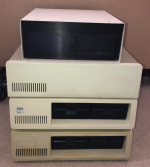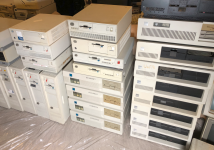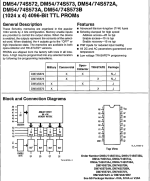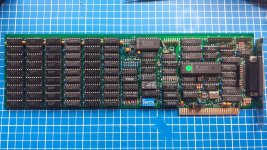AnalogThinker
New Member
- Joined
- Feb 9, 2023
- Messages
- 9
Hi everyone,
[Presentation]
I am located in Canada, and have been fixing Computers for a while now (mostly on the Hardware level).
My journey with the IBM started when a friend dropped a VERY early revision of a 5150 (SN before 3000)


I spent a good 2 weeks probing thousands of traces to figure out the issues:
Symptoms: Upon turn on, I sometimes had nothing, sometimes a continuous beep that triggered when environment capacitance changed (hovering my hand for ex).
Faults: It's been a while but from what I remember, it was a combination of: Bad 8255A-5 that had one of the outpus stuck in floating (Z) state, a bad track reaching U67, a seriously drifted Crystal, as well as a flaky ROM.
[Current situation]
Now I just have acquired a large lot of IBM machines, and now focusing on the 5150 and 5160 that I am trying to restore slowly.

One of them had a Diamond Flower MF-100 that I need some help with!

Can you spot the issue?
After a couple of hours probing, I realized the Data In of the 4164 was floating with no activity, so I traced it to all the chips and to my surprise, all the pins of the Logic it was attached to were Input pins, no-one was sending Data.
That's where I tried to find pictures and realized it was a Diamond Flower MF-100 and U68 should be a 74280 (but it had a 7432 from factory?!). No wonder it didn't receive anything!
I found the only one I had in my stash and replaced it. But now, we're continuing the troubleshooting.
(BTW I have tested every single chip of that board, RAM and Logic).
It turns out my issue is the U60 (DM74S573N), a Schottky TTL-PROM. It gets the proper inputs from the Jumpers and the Address lines coming from the ISA bus, but it's a dud and all outputs are floating.
[Tricky part]
- All the Datasheet for the DM74S573N out there are for the newer 20pin, except for one screenshot from EEVBlog's forum:

- There is no data on how to "Program" it anywhere, and Datasheet mentions it comes blank.
- I do not have enough understanding on how the additional memory are addressed on Add-On Memory Cards to rebuild a Frankenstein drop-in replacement module.
- I do not have the original 4096 bits table
[Ask for the group]
Is there ANYONE out there that has the same card (I believe it would be compatible with the "Jameco JE-1078", and the "Donatec Ram Exp.") and would be up for a challenge of extracting the ROM and map the 4096 logic table (with an Arduino Routine for example, that I could help build of course)?
And does anyone has any clue how to PROGRAM that ROM. If not, I'll have to find or design an alternate Frankeinstein drop-in solution from a PAL, ROM, or STM32/AVR maybe.
(Or a non-working one for sale, but where's the challenge...)
Anyways, thanks for your Time and Interest!
[Presentation]
I am located in Canada, and have been fixing Computers for a while now (mostly on the Hardware level).
My journey with the IBM started when a friend dropped a VERY early revision of a 5150 (SN before 3000)


I spent a good 2 weeks probing thousands of traces to figure out the issues:
Symptoms: Upon turn on, I sometimes had nothing, sometimes a continuous beep that triggered when environment capacitance changed (hovering my hand for ex).
Faults: It's been a while but from what I remember, it was a combination of: Bad 8255A-5 that had one of the outpus stuck in floating (Z) state, a bad track reaching U67, a seriously drifted Crystal, as well as a flaky ROM.
[Current situation]
Now I just have acquired a large lot of IBM machines, and now focusing on the 5150 and 5160 that I am trying to restore slowly.

One of them had a Diamond Flower MF-100 that I need some help with!

Can you spot the issue?
After a couple of hours probing, I realized the Data In of the 4164 was floating with no activity, so I traced it to all the chips and to my surprise, all the pins of the Logic it was attached to were Input pins, no-one was sending Data.
That's where I tried to find pictures and realized it was a Diamond Flower MF-100 and U68 should be a 74280 (but it had a 7432 from factory?!). No wonder it didn't receive anything!
I found the only one I had in my stash and replaced it. But now, we're continuing the troubleshooting.
(BTW I have tested every single chip of that board, RAM and Logic).
It turns out my issue is the U60 (DM74S573N), a Schottky TTL-PROM. It gets the proper inputs from the Jumpers and the Address lines coming from the ISA bus, but it's a dud and all outputs are floating.
[Tricky part]
- All the Datasheet for the DM74S573N out there are for the newer 20pin, except for one screenshot from EEVBlog's forum:

- There is no data on how to "Program" it anywhere, and Datasheet mentions it comes blank.
- I do not have enough understanding on how the additional memory are addressed on Add-On Memory Cards to rebuild a Frankenstein drop-in replacement module.
- I do not have the original 4096 bits table
[Ask for the group]
Is there ANYONE out there that has the same card (I believe it would be compatible with the "Jameco JE-1078", and the "Donatec Ram Exp.") and would be up for a challenge of extracting the ROM and map the 4096 logic table (with an Arduino Routine for example, that I could help build of course)?
And does anyone has any clue how to PROGRAM that ROM. If not, I'll have to find or design an alternate Frankeinstein drop-in solution from a PAL, ROM, or STM32/AVR maybe.
(Or a non-working one for sale, but where's the challenge...)
Anyways, thanks for your Time and Interest!

